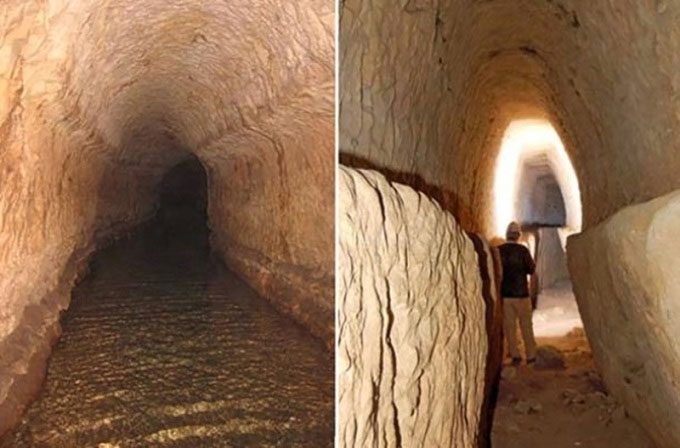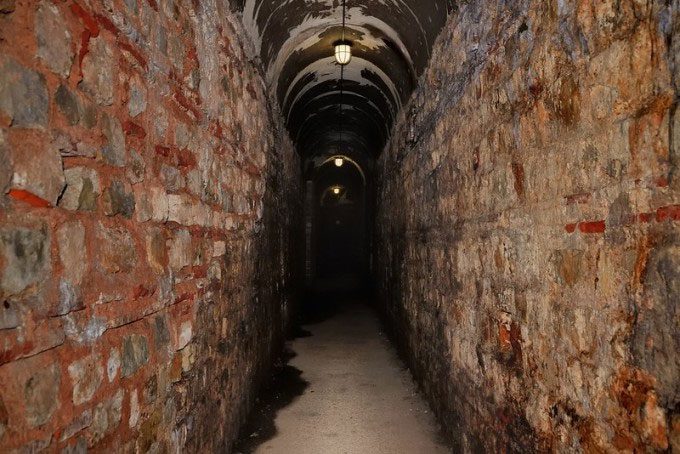Hundreds, even thousands of years ago, long before the advent of modern equipment, humans constructed remarkable underground structures.
Basilica Cistern

Marble columns in the Basilica Cistern in Istanbul. (Photo: Xinhua).
Hidden beneath the city of Istanbul, Turkey, are hundreds of ancient cisterns that once stored and supplied water to the residents of bygone eras. The largest of these is the Basilica Cistern, so grand it’s known as the “Sunken Palace.” Constructed by Eastern Roman Emperor Justinian I in 532 to address the city’s water shortage, the cistern measures 138 meters in length and 64.6 meters in width, covering nearly 10,000 square meters and capable of holding up to 80,000 cubic meters of water.
The construction of the Basilica Cistern involved incredible craftsmanship, featuring 336 marble columns that support the structure. According to some experts, most of the columns were repurposed from older buildings. The cistern ceased to be used after the 10th century due to the high costs and labor required for maintenance. Over the years, tons of mud covered the cistern until it was rediscovered and reinforced several times, starting in the 18th century.
The Gadara Aqueduct

The Gadara aqueduct underground. (Photo: Ancient Origins).
The Gadara aqueduct was built to supply water to a cluster of 10 Roman-Greek cities, now located in modern-day Syria and Jordan. This aqueduct, with its astonishing engineering, belonged to the Roman Empire and was likely influenced by Persian techniques.
Spanning 170 kilometers, the system is not only the longest ancient underground aqueduct in the world but also the most complex. The construction was executed with remarkable precision, featuring a very slight gradient, dropping only 30 cm per kilometer. The Gadara aqueduct transported fresh water from sources over 100 kilometers away to the western suburbs of the city. Upon completion, workers excavated over 600,000 cubic meters of limestone, equivalent to more than a quarter of the total mass of the Great Pyramid of Giza.
Derinkuyu Underground City

Tunnel leading into the Derinkuyu underground city. (Photo: Travel Turkey).
Beneath the cobblestone streets of Derinkuyu lies an ancient network of tunnels and living quarters capable of sheltering 20,000 people. Situated over 85 meters deep and consisting of 18 levels, it is the largest underground city ever discovered.
The site was rediscovered in 1963 when a local man kept losing chickens. After noticing the birds fell through a crack while renovating his home, the owner found a dark passage leading to the complex. Hundreds of homes in the area also had hidden entrances into the underground metropolis. Interspersed throughout the complex are rooms that were once used for meetings, livestock pens, kitchens, storage, and small prisons. The structure even has an effective ventilation system that allows fresh air to circulate deep within the maze.
The Derinkuyu underground city primarily served as a refuge during wars or difficult times. The dating of the city remains a topic of debate among scholars, but some estimates suggest it was built around 2,800 years ago.
Margate Shell Grotto

Margate Shell Grotto in England. (Photo: Keith Edkins).
What makes the coastal town of Margate in Kent, England, special is the presence of the Margate Shell Grotto. In 1835, the local school headmaster, James Newlove, wanted to build a pond in his garden. While digging, his shovel fell into a large crack beneath a rock. He lowered his son down with a rope to retrieve it. However, when the boy came back up, he reported seeing beautifully decorated shell tunnels beneath.
Subsequent excavations revealed a stunning grotto containing over 4.6 million marine shells embedded in a 600-square-meter mosaic. What adds to the mystery of the Margate Shell Grotto is that experts have no information about this structure. They are unclear about exactly when it was built, by whom, and for what purpose.
Rome’s Tunnel Network

A part of the tunnel network beneath Rome. (Photo: Ancient Origins).
Below the streets of Rome, Italy, lies a network of tunnels and quarries that date back to the early days of the city. Originally, these tunnels were used by ancient Romans to extract stone for the city’s construction. As the city expanded, buildings were constructed above these tunnels. Later, when quarrying ceased, the ancients began using this underground network for catacombs, mushroom cultivation, and drainage systems. During World War II, they were even used as bomb shelters.
“There are hundreds of kilometers of tunnels running beneath the city and its suburbs. Parts of the network have been understood and opened to visitors, while other sections remain largely unexplored. There are likely many lost catacombs,” said Adriano Morabito, president of the Roma Sotterranea association.


















































